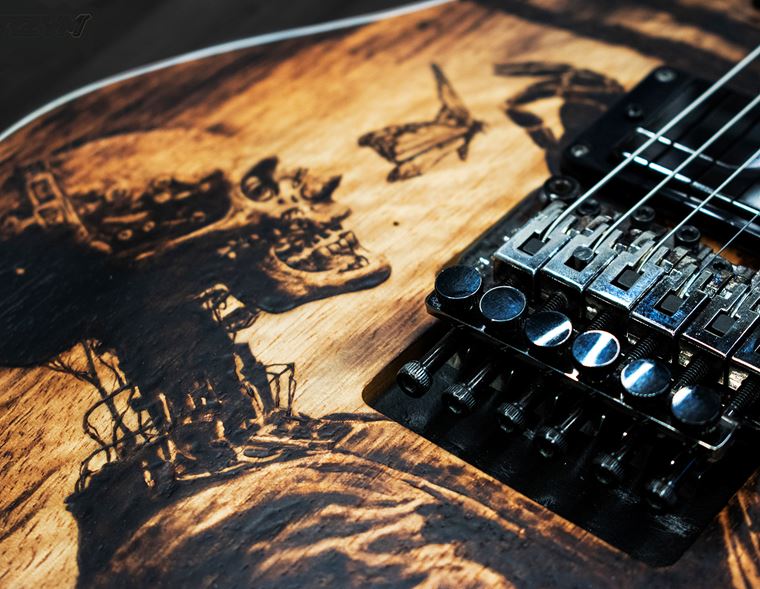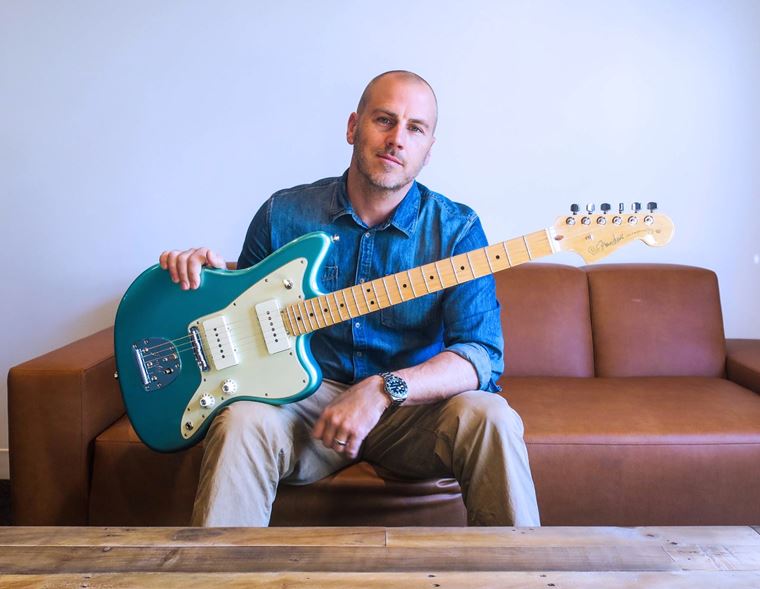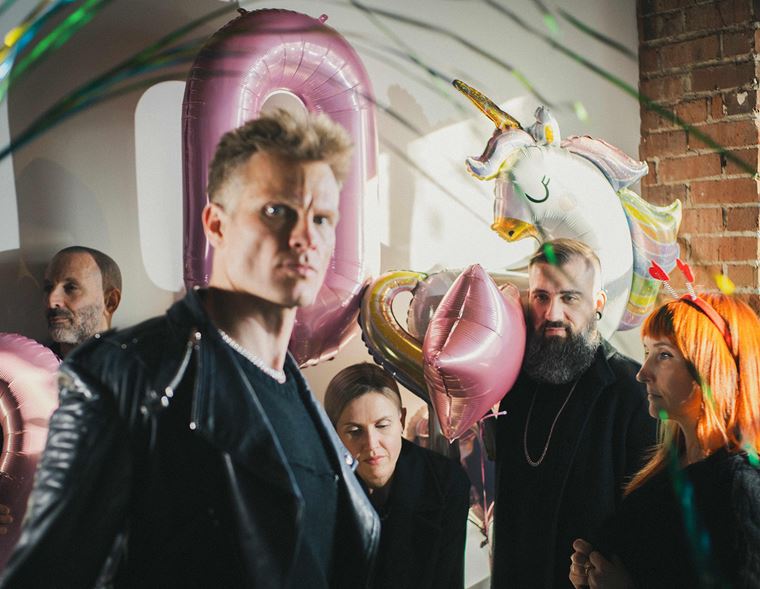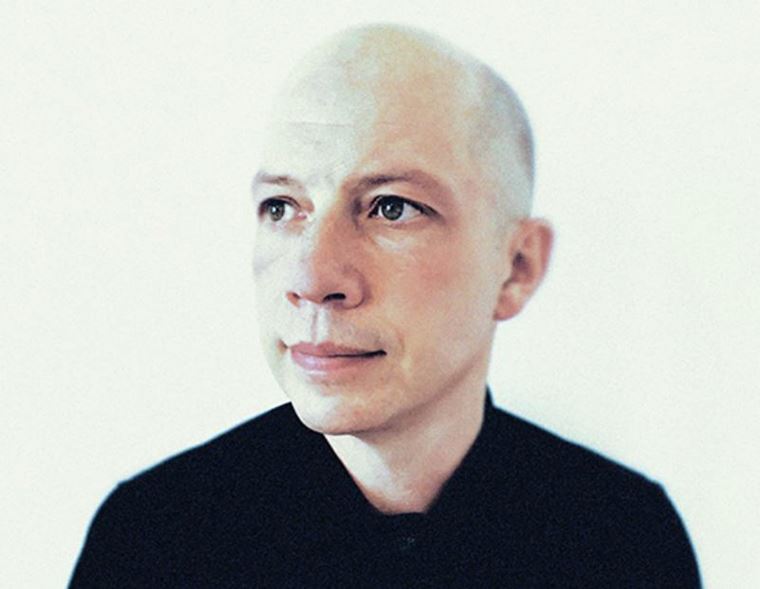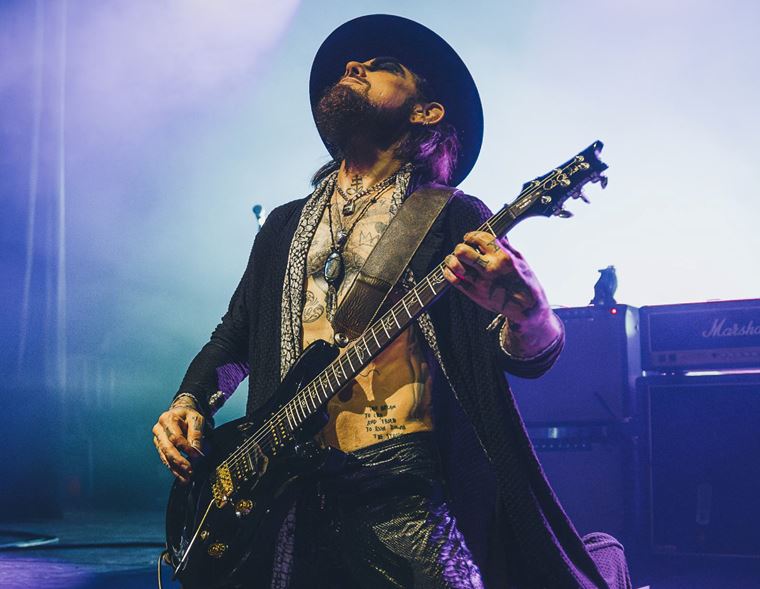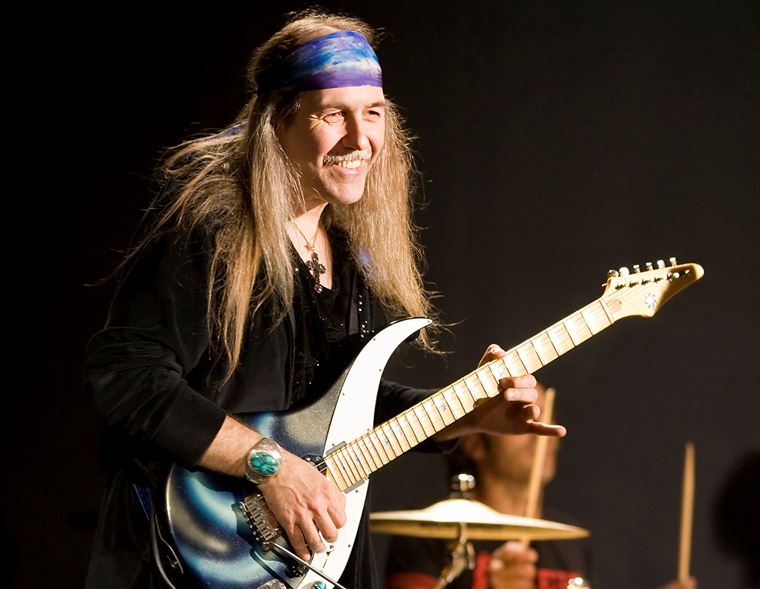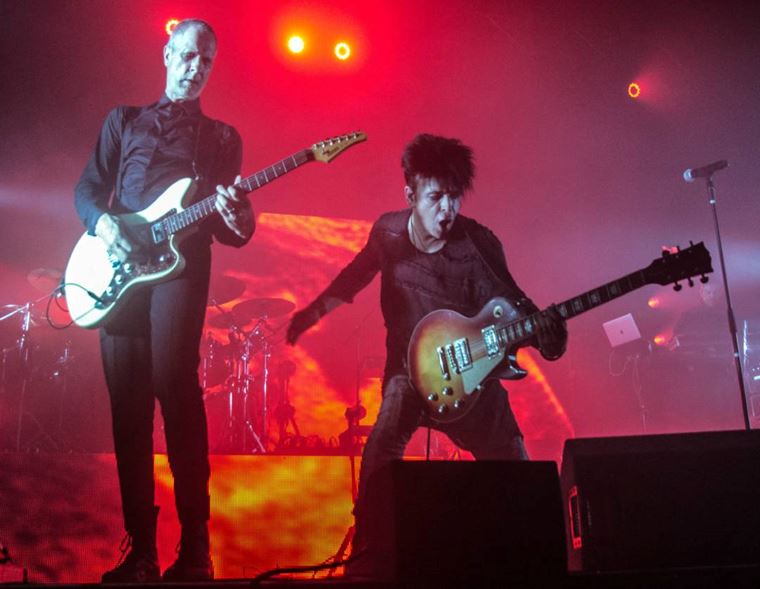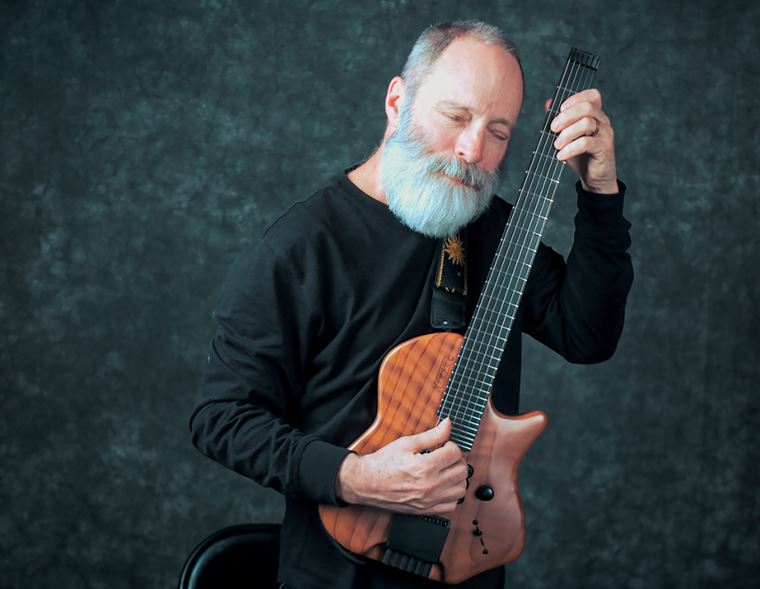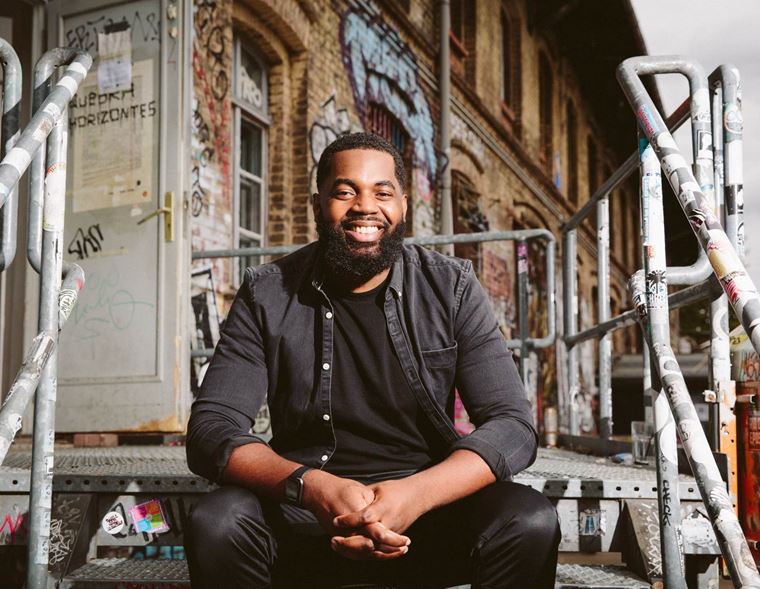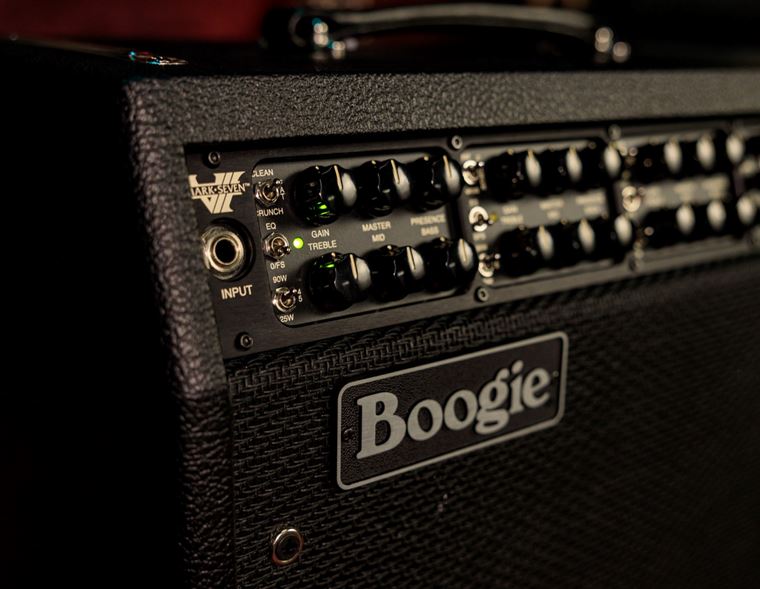PETER GABRIEL: Exclusive Interview with guitarist DAVID RHODES! Touring, Selling Vintage Strats and Playing with Kate Bush!
It’s a bright, sunny morning when we make contact with Peter Gabriel’s guitarist of 40+ years, David Rhodes. He’s on the balcony of his hotel room in Hamburg, enjoying the view. ‘There’s a lake behind us, with winds blowing, people are sailing in little boats”: just the level of relaxation required for some morning respite amidst a huge globe-trotting arena tour.
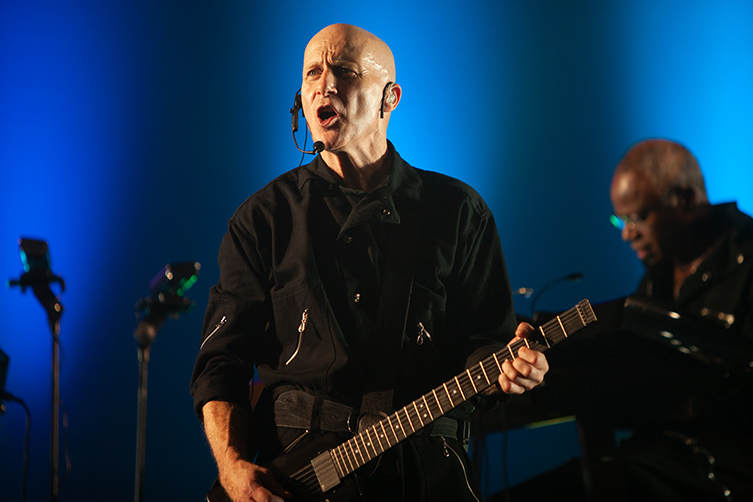
(Photo courtesy of York Tillyer/Real World)
We’ve caught up with David to find out more about his work with art-rock pioneer and ex-Genesis singer Peter Gabriel. Gabriel and his band (which also includes King Crimson bassist Tony Levin) are currently touring in support of I/O, an album over two decades in the making and - unusually - at our point of talking, still unreleased! Six songs have been released (one every full moon this year so far) but currently there is no definite ETA for the full record. We wanted to hear more about this most unusual of decisions, as well as gaining some insights into the day-to-day goings on of a touring guitarist on a major arena tour.
David has been one of Gabriel’s main right hand men since 1980, but he has also played with the incredible Kate Bush, and so we had to learn more about that, too! Luckily, David was a wonderful person to talk to, and happy to share anecdotes of a life lived performing with some of the most magnetic musicians in the world. As the sun beamed over Hamburg (and a dodgy wifi connection threatened to derail our conversation more than once!) we had a most entertaining and illuminating chat. Here it is, transcribed below…
The Early Days - Puppets and Pints
Guitarguitar: So, this will mainly be about the Peter Gabriel stuff of course, since that’s what you’re doing right now, but one interesting place to start might be how you actually began. I’ve read about you studying sculpture and also performing with a puppeteer? That to me sounds amazingly theatrical and I wondered if you came to music via an arts background?
David Rhodes: It’s funny because I was talking about this to some of the other American musicians on the tour. There was still a feeling, up until about twenty years ago, that a lot of british music came out of art schools. I think that’s quite an important difference. My guess is that even the people who were bunking off and not doing any artwork, they’d still be influenced by that environment.
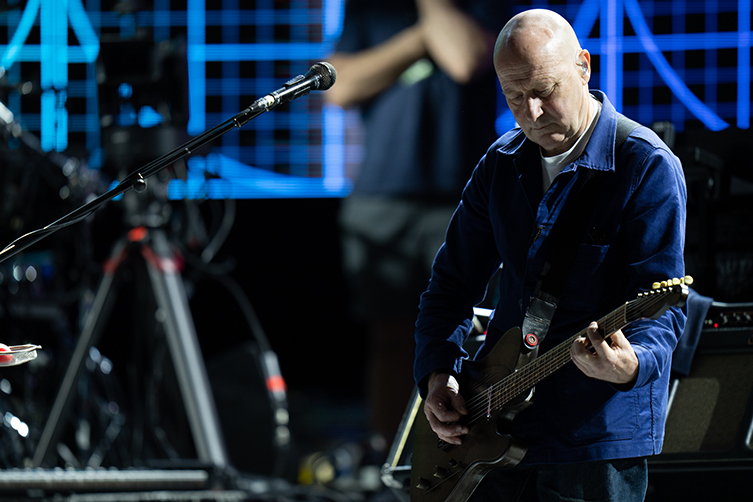
(Photo courtesy of York Tillyer/Real World)
I didn’t get into music specifically through being involved in performance, but that felt like an important part of what we were doing. We just did very experimental soundscapes at the time, using an old TEAC 4-track machine. You could bounce as it went from record head to playback head, but anyway, the performances came after creating those experimental pieces. It was kind of ‘how do we perform these to an audience?’. We initially had a slide show - well, a slide per song - and they weren’t even songs, they were tunes. Actually, they weren’t even tunes, they were barely music: it was just noisemaking, which was great! My partner at that time, David Ferguson - who died quite a few years ago now - he would play stylophone and bass but he actually couldn’t play either (laughs) and I couldn’t really play guitar, so I was just scratching away. I think we shared a phaser, haha! That’s the extent of it.
GG: That sounds brilliant! So, from that kind of…I’m still going to say theatrical background, because that isn’t playing Motorhead tunes at the pub, that’s quite a creative set up. To me, it makes you sound quite predisposed to being someone that an arty, theatrical man like Peter Gabriel would be interested in. So, how did that happen?
DR: So we went from working as a duo like that, working with a puppeteer, to getting a four night residency at the Rotherhithe theatre. In those four nights, we played to twenty four people in all! On the fourth night, of the four people, we knew two of them quite well (laughs) and we got half way through the show and the puppeteer just went, ‘Do you know what? Let’s go to the pub!’. We all went to The Ship and had a couple of pints and said, ‘yeah, we’ll just tell you what we were gonna do!’ (laughs) He’d actually been my tutor at St Martins (art school in London - Ray), nice guy, Dave Finlay, but on the drive home, David Ferguson said to me: ‘do you know, we should be writing songs. We’re not getting through to people’.
We then bought a Roland drum machine that had four types of beat on it, you know: Bossa Nova, blah de blah, blah de blah. And then we started trying to write songs, which neither of us had really done. Within a year, we’d signed a record deal with Polydor.
GG: Wow!
DR: We‘d started gigging, found a couple of members: drums, bass and another guitar player, actually. I was trying to remember, I’m getting old! Anyway, we did shows around the London pubs, we’d go up to Oxford and an artist called Graham Dean saw it. He’d had some contact with Peter, who was trying to put together a band to do his third album, and Graham suggested us.
"Peter's really playful and always has been. Even working on something intense, it's fun, it's play and it's interaction. That's the key thing."
We were playing at the Rock Garden and we’d signed the deal with Polydor the week before. Peter came along with his manager Tony Stratton-Smith, who was with Charisma, and a whole gangle of people came along. From that, we ended up signing with Peter’s manager Gail, and we signed publishing to Hit & Run, because in those deals people wanted to keep publishing separate from recording. That was the start, really.
We went a week or two later and did demos with Peter and from there, he asked me to work on the third album (nicknamed ‘Melt’), which was a kind of trial by fire, really. I’d never done a session for anyone! The first session I did, I walked into a room with Peter, John Giblin, Jerry Marotta, with Steve Lillywhite producing. It was like, ‘oh fuck’, hahaha! Peter was great with me, but everyone else, I think they felt I was a bit under-powered. I guess we found a way of getting through it.
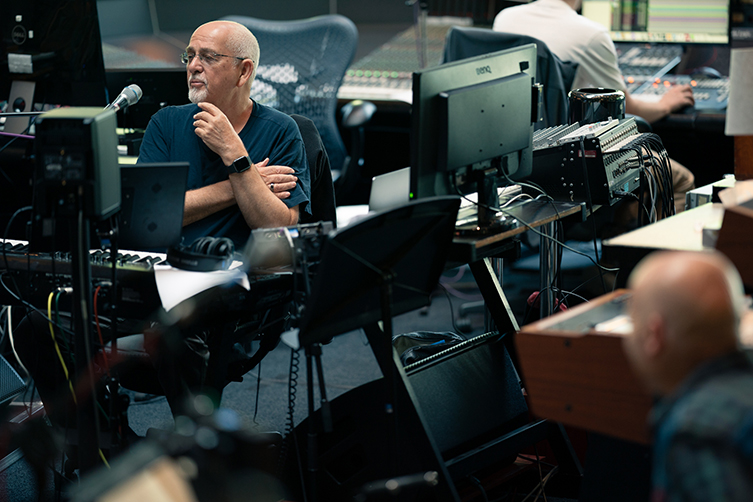
(Photo courtesy of York Tillyer/Real World)
Recording with Peter Gabriel
GG: Mm, yeah! It’s an interesting thing being a guitar player in Peter Gabriel’s band - well, I’m saying that: I don’t know! - but you’ve had over 40 years of a musical relationship with him, recording and touring. Being that Peter’s not a guitar player, and he tends to write with drums and keyboards, at what stage do the guitars become a part of the music? Are you in there from the beginning?
DR: Well, he used to start earlier with the band, so on the third album, we were actually putting down rhythm tracks together. It was like that on the 4th album too (the first four PG solo records are all self-titled, so nicknames are used based on the album art: the 4th one is nicknamed ‘Security’ or ‘Intruder’ - Ray), because you didn’t really have the facilities to have demos fully prepared that you could then add to or subtract from. So, there was a lot of experimenting with the band. He’d go, ‘I’ve got these ideas’, and he’d bash them out on the piano and you’d try and work out your parts there.
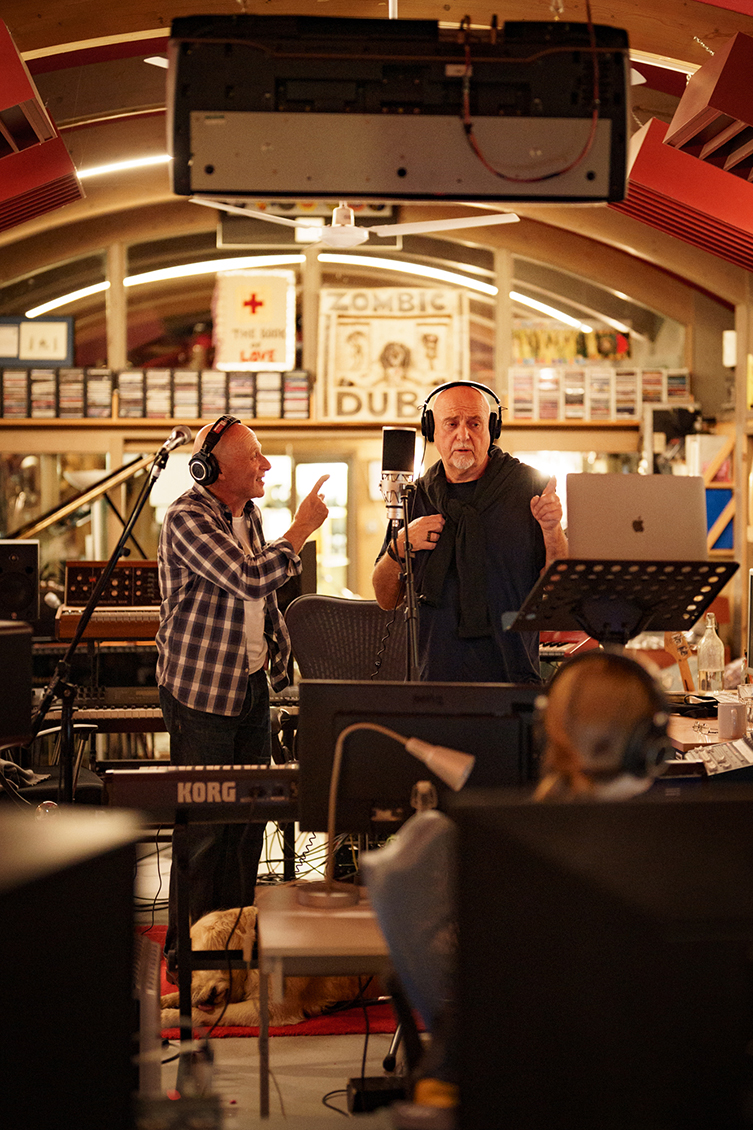
(Photo courtesy of York Tillyer/Real World)
Then with So, I was in early, working with Peter and Dan (Daniel Lanois - Ray). Dan and I would both play guitars whilst Peter was kind of roughing it out: some ideas were rougher than others, so we’d just go through them and work them out. I guess Us was pretty much like that too, but by the time Up came around…sorry, I’m just thinking aloud…on the third album, he had a little programmable drum machine called a Paia, which dropped its memory every time you switched it off. Originally, the sound for Biko was just (makes ‘boop boop’ noises) and we’d play along to that.
Then by the time the fourth album, would the first LinnDrum have come out? I think he’d started programming by then, he got into that a bit. By the time of Us, he’d got things more prepared in the rhythm department and whatever. By Up - you know, years later - he was making much more fully formed demos, which I played the guitar parts along with.
Coming up to date now, his demos are really fully formed, and so as a band, we played along with the pretty-much existing song. He had the lyrics, which is very rare: he used to not have the lyrics at all, early in the process.
GG: Right! So, this is the new - and somewhat unusually unreleased - I/O record we’re talking about. Are there three tracks released so far?
DR: Yeah, there are six tracks out now.
GG: Oh, I’ve missed a couple! So, it’s an unusual thing for such a big act to be touring an album that isn’t out yet. Was that a deliberate thing, or just how things occurred?
DR: I don’t know, I mean, it seems like a slightly odd decision but Peter delights in being playful and quirky, I think. Actually, I think he’s also reached the time in his life when he doesn’t really give a fuck! (laughs) Which is fun! He’s just said, ‘Well, this is how I’m doing it. This is how I want to do it’.
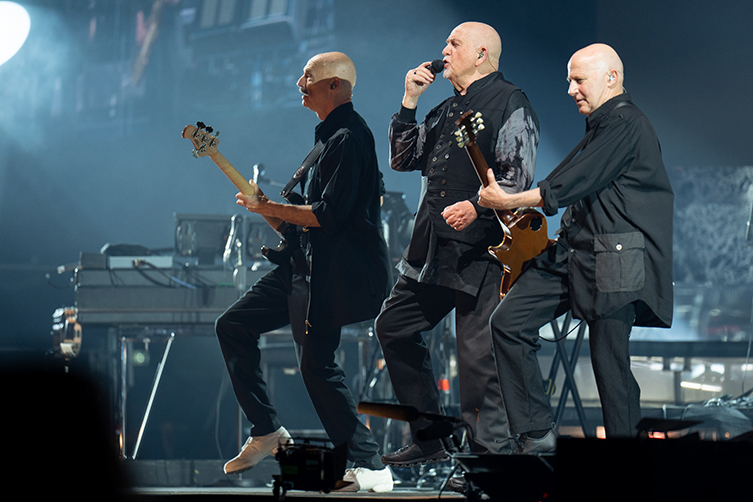
(Photo courtesy of York Tillyer/Real World)
GG: That’s great! That actually leads into one of my questions, and when I wrote it, I wondered whether it has a bit flippant or glib, but given what you just said, maybe it is worth asking! You’ve been working with Peter on and off for over forty years. I get the idea - from not knowing him - that he seems to be a really fun person. Is that one of the main motivating factors for you to stay for such a long time in one particular creative place? You just get on really well with the person?
DR: Yeah, I think he’s very playful. And he always has been. That’s a big part of how he works. You know, even working on something intense, it’s fun. It’s play and it’s interaction, that’s the key thing. And then on stage, it's a mixture of serious and very playful, and it’s exactly that dichotomy or that balance that really works for him and what he does.
"We got about half way through the show and the puppeteer went, 'Do you know what? Let's go to the pub!'"
Touring Life
GG: That’s really well put. This is a huge tour, and most of the people who’re going to read this article will know Peter Gabriel of course, and they’ll understand the size of the venues and so on. Most of us probably haven’t played gigs quite on that scale. As a part of that, as a gigging guitarist on a huge tour: what are your responsibilities throughout a typical day?
DH: Well, I mean, we’re very well looked after. We’re lucky, we stay in nice places. The travel is as easy as possible. Yesterday, we had a three and a half hour train journey rather than a four hour car journey: It’s just nicer to be on a train than in a car! It’s made as easy as possible.
So today, we’ll leave the hotel at 2.30pm, go to the gig, probably won’t soundcheck till about 4pm, but if people want to eat, they can eat. I tend to eat after soundcheck, and then, you know, you start preparing for the show around or just after 7pm for an 8 o’clock start. And yeah, soundcheck, but soundchecks are getting shorter and shorter! (laughs) Sometimes we’ll do three tunes, maybe two and a half, and any little moments that anybody wants to check. It’s quite a big band, and the youngsters are very on it, they’re all very sharp. Us older folks are a little more lax, but that’s fine: that’s how it is.
GG: That’s how it is! One thing I wondered about: the music you play on has lots of layers on the recorded work. It’s keyboards, samples, Fairlight, rhythms, in addition to the guitar parts. I was wondering: given that you played the guitar parts on the records, when you come to tour, do you try and stick mainly to what was recorded, or is there licence for you to change things up?
DR: Generally, I think I’m still playing some parts that I liked, that didn’t make it to the records! (laughs) I’m not sure about that! I think Peter trusts me to mostly play what’s on the record, and then sometimes to not necessarily do what’s on the record! Like, maybe do parts that I had played before he put strings on, because the strings changed some songs, broadened them, and also changed some of the rhythms slightly. So yes, I’ve gone back maybe to some original parts. And Richard Evans is doing some of the more textural things where the engineer has taken what I did and mashed it up.
GG: Ah, interesting!
DR: Richard’s covering a lot of those. I’m playing the more direct bits, quite often.
"I think attitude and comittment are the main things. And to not be afraid. You've got to try things, and making mistakes is fine."
GG: Okay, yeah. Now, I don’t actually know what the setlist is - because I’ll be at the Glasgow show and I don’t want to know haha! - but I’m thinking of older songs like San Jacinto, where there aren’t any guitars for ages and then they come in for the big ‘hold the line’ part.
DR: Yeah, actually we rehearsed it, but we’re not doing it. Sorry to…
GG: Ahh, sad!
DR: Haha! But yeah, what I’ve done when we’ve performed it is, I play one of the keyboard parts, some of the sequenced stuff, so its (hums an arpeggiated keyboard part) and I derive great pleasure from playing a little repetitive part like that! I’m a simple soul!
GG: No, no, that’s what it’s all about! That was actually another one of my questions, which you’ve kind of answered there but maybe we can expand slightly. Being that you’ve performed a number of tours with Peter, has your role changed much from when you started out to today? You mentioned there about the keyboard on San Jacinto…
DR: Um, I think Peter’s always appreciated the fact that I don’t approach the guitar in the way that a lot of people do, like wanting to solo and whatever. I just don’t do that. I like to be part of the melange of keyboards and guitar so you’re not even sure which is which. It doesn’t matter to me, I’m just making a noise to support the General, so that Peter can sing well.
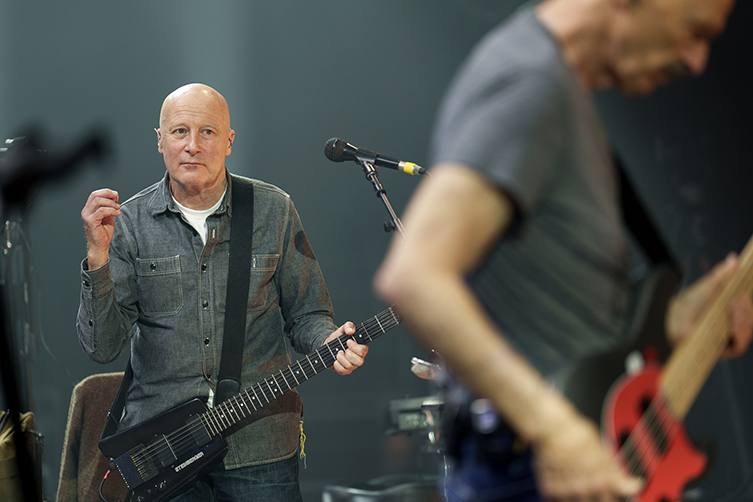
(Photo courtesy of York Tillyer/Real World)
GG: That’s a great way of putting it!
DR: So it’s just fitting in, really and fitting in, rhythmically. I was talking to Manu (Manu Katche - drummer and vocalist - Ray) about it the other day. When we went out on the So Revisited tour, that was very much a ‘rock’, powerful small band, whereas this is much more arranged. It’s more harmonically complex because we’ve got a couple of string players, a trumpet and Richard, so there are a lot of layers and textures. It’s nice, it’s quite different!
Guitars, Effects & Live Sound
GG: Sounds brilliant! I’m really looking forward to the show! So, given that this is for guitarguitar, let’s talk guitars! What are you using for this tour?
DR: Okay, so, guitars. I’ve got a Les Paul Robot, a Studio, that I bought years ago to do little solo shows, so I’d be able to change tunings. The tuning system is knackered now, so I just keep that in Eb.

(Photo courtesy of York Tillyer/Real World)
I have a Goldtop that I bought in the early 90s which is a reissue. It’s got either P90s or P100s, I can’t remember. But it’s nice, it’s sweet. I wasn’t going to use that, but my tech thought I should bring it along, and I’m using it a lot. That’s in regular tuning. And I’m using a James Trussart Tele.
GG: Nice.
DR: I’ve had it for nearly twenty years. I bought that second hand in San Francisco when we were on the road. So those are the three main instruments, and I still use my old Steinberger 12.
GG: Yasss, I like those!
DR: It’s better for tuning that just about any other 12 string I’ve ever tried. I still need to check it all the time (laughs) but it holds the tuning better than most twelves, I think. Oh and I bought a Guild acoustic baritone. I’m not that attached to the guitars: they’re tools. But strangely, I do like the red Les Paul, the Studio. It’s a relatively cheap instrument but they’re great. Functional.
GG: I’m interested in talking a little more about that, actually. I’m fond of the Les Paul myself, but my first instinct, before I looked into what you were using, would be that a Peter Gabriel gig would be a Strat gig, because it seems that Strats are easier to fit into bigger ensembles. You know how they are skinnier sounding? A Les Paul has more width, you know?
DR: Yeah, I mean I don’t know how much they’re EQing me these days! (laughs) But I’m a front pickup guy too, I always play on the front pickup. When I first worked for Peter, I had a Jazzmaster and a Strat, for years. I guess my first Les Paul was the Goldtop. There’s something I quite like about the heft of a Les Paul, and I know most people go the other way: they start off on Gibsons and then say, ‘Actually, I’m gonna be better on a Strat’, but I had a really beautiful 62 Strat for years that I bought relatively cheaply in the early 80s. I stopped playing it because I thought it sounded too generic, almost. My family actually needed a new septic tank, a bio-unit because we were living out in the country, so I sold the Strat! (laughs) Every time I walked past the septic tank I kind of regretted it, haha! Never mind!
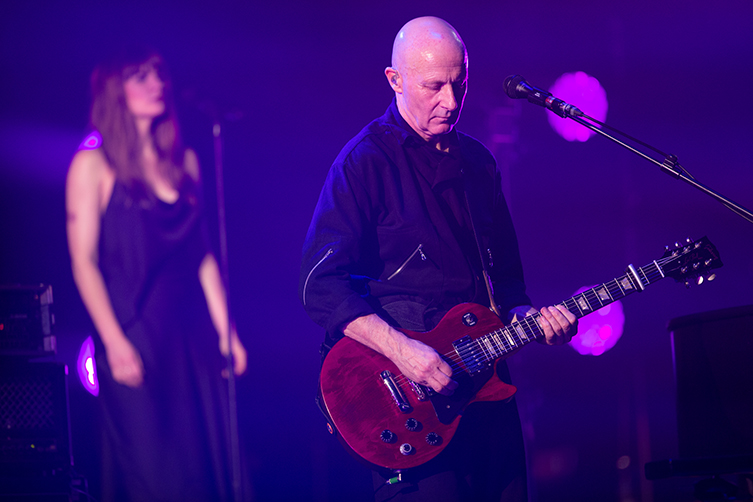
(Photo courtesy of York Tillyer/Real World)
GG: That’s such an adult decision, isn’t it? The vintage guitar for the septic tank!
DR: Yeah! Haha!
GG: What about things like string gauges and plectrums; do you have preferences?
DR: Yeah, I use 11-48 strings because I like using effects. I think if you have a thicker signal to begin with, the effects are going to work better. And then also, when I first started playing, I used to break a lot of strings. I used Herco silvers, or grey or whatever, and Peter Hamill, who produced the album with my band said, ‘If you’re breaking a lot of strings, why don’t you go down a gauge and use Herco golds?’ I’ve used those ever since!
GG: Wow, they’re really light, aren’t they? Like, 0.50mm?
DR: I don’t know, but they’ve got enough give in them to make groove playing comfy, and just enough weight to make a good noise.
"I had a beautiful '62 Strat for years but I stopped playing it because I thought it sounded too generic, almost!"
GG: Okay, cool! I’m really interested in effects, too. It’s a big area for guitar players, especially when we can now have good digital things like the Helix and the Quad Cortex. We’re finally at the point where all of that stuff is good enough for the pros to use. Upon checking your Instagram, it looks like you’re still using your stompboxes and valve amps. Is that just what works for you?
DR: That’s not strictly true (laughs). Basically, the core of what I’m doing is, I’m using a Helix. It’s new to me in terms of using it with Peter. Then, with that, I’ve got three sends: one is to a Roger Mayer Voodoo-Vibe, which I’ve always like the sound of; another is to a vibrato pedal, a latching one like the old DC-2. Then I’ve got another send that I’ve got on for some songs, a Rivera distortion, but in fact I haven’t been using that, really. I’m using a Rivera amp - I’ve a pair up there but I’m only using one - for a little bit of onstage sound.
However, the caveat is that I’ve been talking to my tech these last three days: we’re wondering whether to go back to all-analog.
GG: Oh really? That’s interesting! What’s the debate there?
DR: It’s just that the sound…modelling is great, but is it just too even? I think it maybe evens things out too much.
GG: As in, there isn’t that slight hazard of reality there?
DR: Yeah, and I wonder if everything feels slightly squashed. Very slightly! I mean, we’re undecided. My tech Chris is great. He listens to my rig every night as I’m playing, and actually, the spare guitars are often his. I forgot, I use a Blade guitar for Red Rain.
GG: Ah, so you’re playing Red Rain? That’s good news!
DR: (laughs) Sorry! Yeah, so that’s his and then there’s a kind of semi acoustic Gibson, a 335 shape but smaller. What would that be?
GG: Oh, it could be two: most probably a 339, though.
DR: Yeah, I think it might be that. That’s a nice instrument, I used that when we did the Peter and Sting tour. Chris has better guitars than I do! He’s a great sounding board and he just threw it at me the other day that maybe we should go back to analog. I don’t know if the sound man would like that, because the great thing about the digital world is that you’re getting exactly the same levels every night, so it’s very predictable. I like to think I’m a consistent player but I get that the analog world is a little more lairy then the digital.
GG: Would an audience member hear just the Helix or would they get a little bit of the amp too?
DR: All just Helix at the moment.
GG: That’s amazing! Now, there are two quotes of yours I like from some research that I’ve done. One is ‘I stay well away from reverb’, in terms of your live sound. Is that something you continue?
DR: Yeah, I never use reverb live, ever. I used to, years ago when I first worked with Peter. I thought it was important. But I think that to add reverb when somebody’s trying to control a big room is just asking for trouble! You’re just giving somebody more problems. I’ve never discussed it with anyone, actually! (laughs) I do think: why give somebody a sound that has reverb on it when the room is dictating what the music sounds like.
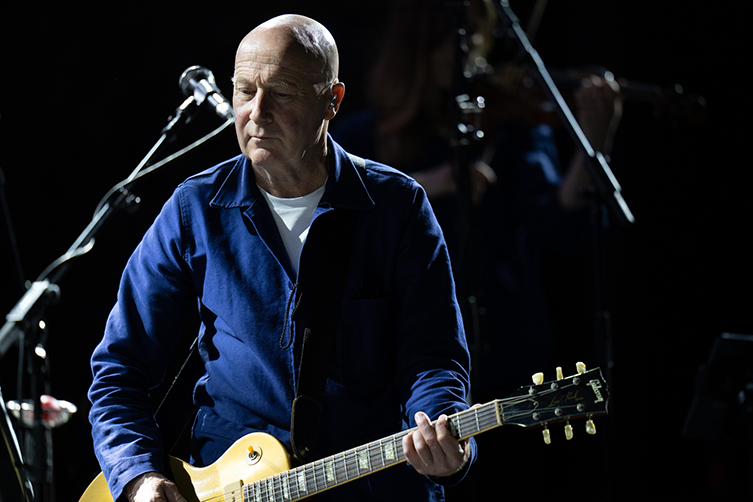
(Photo courtesy of York Tillyer/Real World)
GG: Yeah! Would that imply that you’re already encountering a certain amount of actual, natural reverb anyway, so why add to it?
DR: Yeah. Particularly in rooms above a certain size. I think if you were playing acoustically in a great, small room where you can really hear the intricacies then sure, there’s a place for it but I think on a guitar in a big room, I’m not sure it’s valid.
GG: Yeah, definitely. So for ambience, would you use delay instead?
DR: Yeah, I use a lot of delays.
Kate Bush
GG: Excellent. Now, I’m a very big Kate Bush fan, so any opportunity to talk to someone who has worked with her is one I’d love to take, especially given how hard it is to get hold of Kate herself! So I wonder, was it through Peter that you first met Kate?
DR: No, I never met Kate until I started working for her.
GG: Ah, okay!
DR: Well, she’d sung Don’t Give Up when we played at Earl’s Court during the So run back in the middle 80s and I didn’t meet her then. I guess she’s shy or just reticent to meet people. So, the first time I met her, we were on the So Revisited tour, Back to Front. We were in Dortmund and I got an email from somebody saying ‘please could you give me a call’. It turned out that it was her manager. He said ‘Would it be okay if Kate called you in the morning?’ I said sure, you know? She can call me. She calls me at about ten o’clock, my time - so 9 o’clock her time - so I’d have had my breakfast. All good. I went back to my room and was just looking at the paper online and the phone rang. It was in those days when I guess businesses could withhold numbers, so you’d get no caller ID, and I’d completely forgotten she was gonna call. I answered ‘And what do you want?’ (laughs) She went (adopts small voice) ‘Oh, it’s Kate, it’s Kate!’ It took me about ten minutes of back pedalling to make things easier.
But she then told me what she was planning, and the connection was actually through James Guthrie, the engineer/producer who used to do the Floyd stuff, and who’d worked with her a lot. He’d suggested me which was very kind. And so I met with her because she was going to use John Giblin too, of course, so the pair of us went along to her flat in London. We just sat and had a chat about, actually about other musicians who might be suitable. So that was quite interesting.
Then we went, I guess a few weeks later, just the three of us, to do some pre-rehearsals at her studio. Just gently going through two or three things - well, quite a few things - but generally trying to find our way. She’s lovely to work for, very funny.
GG: Oh, good!
DR: Yeah, I actually think back on that little period very fondly and happily, it was great.
GG: So that became Before the Dawn, that run of shows in London. It must’ve been great for those who made it along, but for the rest of us, well, none of us have seen it! There’s no released video footage.
DR: Yeah.
GG: We can hear it, but I was really hoping for a DVD or something. Because of that, I don’t really know much of what you might’ve been called upon to do? I’ve seen this fantastic picture of you wearing a beaked mask! What was going on?
DR: Haha! There’s another quite long story behind that. We did two blocks of rehearsal with the whole band out in an old school in Oxfordshire. In different areas, the visual people had been working on different things and Adrian Noble was kinda directing. The tour manager said ‘oh and here’s a script of the show’, you know, kinda what goes on. I think I was the only person to read it right through (laughs) and at the end, it said - I’ve forgotten the name of the tune but it’s that stomping tune in three - but it was basically the closing of the show (I think it was Cloudbusting - Ray). It says in the script ‘the guitar player gets off the riser and dances with Kate’. So I read this and I couldn’t picture Frissi (Fridrik Karlsson), the other guitar player, doing it so I kinda thought, ‘oh, that’s gonna fall to me!’, (laughs) which was another of those ‘oh fuck’ moments!
"I was trying to watch what Kate was doing through these little holes in my mask, react to that physically and play!"
We were rehearsing at Hammersmith, getting into the production rehearsals and it was that kind of thing: ‘Oh David, David, you’ve got to get off your riser now!’ We started very gingerly. Well actually, initially I think I was having to dance with the stage manager, which was quite funny in itself! But for the shows, we all put on bird masks and my one was the only one with feathers sticking out the top and colourful. Yeah, we did a dance whilst there was some other stuff going on around us: other bird figures, dancers dancing across us and whatever. Actually we never choreographed it, it was never fixed.
GG: Wow!
DR: We kind of fell into a way of doing things which was lovely, and Kate had one big black wing - I can’t remember which arm it was on - and I was trying to watch her through these little holes in my mask, trying to watch what she was doing, react to that physically, and play.
GG: That sounds absolutely incredible.
DR: I must say, I haven’t listened to it but I will do: I’m getting close to wanting to.
GG: Cool. So, that did get filmed, didn’t it? It just hasn’t been released?
DR: Yeah, we filmed over two days, I think. But I think Kate just decided not to go for it.
GG: So it goes. Between that and the more dramatic elements of Peter Gabriel’s tour, there’s a through line of theatricality, it’s not just standing there strumming chords and looking at your feet. Am I right in that assessment?
DR: Well , this is more visual than theatrical. There’s no…we don’t do as much as we used to. But it’s very, very visual.
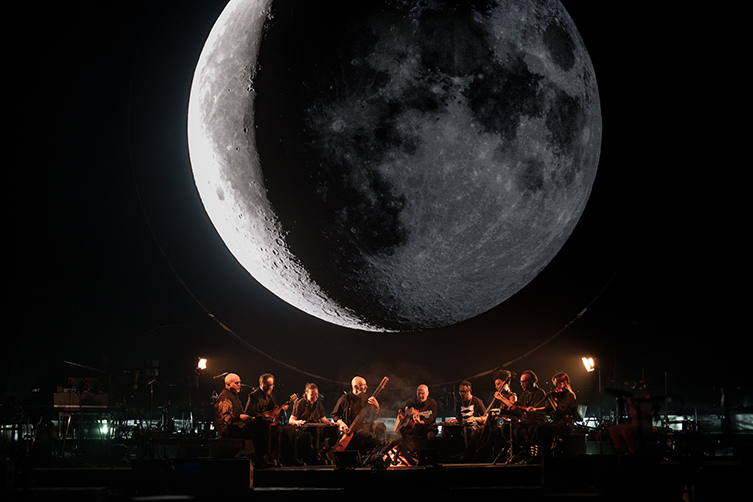
(Photo courtesy of York Tillyer/Real World)
GG: One nice thing to round off the interview might be another quote of yours that I really like: ‘Do what you want with commitment. If they don’t like it, they can leave’. I think that’s such an amazing perspective to have! Given that you’ve had a range of highly successful but relatively unusual gigs for a guitar player - including stuff we haven’t spoken about such as gigs with opera singers and so on - I just wondered if you had any little pieces of advice for other guitar players reading this, who want to have a similarly unusual but successful musical life?
DR: Well, I think attitude and commitment are the main things. And to not be afraid. You’ve got to try things, and making mistakes is fine. It’s not an issue. But yeah, to be committed is essential. I’m just reminded (laughs) of a bloke’s pedalboard probably 30 years ago. It had taped onto it: ‘Remember to make shapes’! (laughs)
We’d like to thank David for giving up a precious Hamburg morning to chat to us! It was definitely our pleasure. David will be playing on Peter Gabriel’s I/O tour throughout the Summer and beyond. Please click through to the official Peter Gabriel website for details, tickets and all the rest. It promises to be a tour not to miss!
We’d also like to thank Amy for all of her help, and of course to you for reading this exclusive interview! We have over 150 more online and available to read, so please do click through to the guitarguitar interviews page for more!



